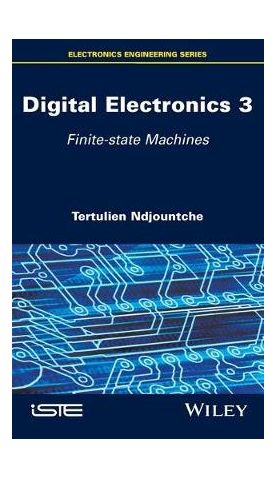אנו משתמשים ב-Cookies כדי לשפר את החוויה שלך. כדי לקיים ההנחיה החדשה של e-Privacy, עלינו לבקש את הסכמתך להגדיר את ה-Cookies. קבלת מידע נוסף.
786.00 ₪
Digital Electronics V3 - Finite-state Machines
786.00 ₪
ISBN13
9781848219861
יצא לאור ב
London
זמן אספקה
21 ימי עסקים
עמודים
330
פורמט
Hardback
תאריך יציאה לאור
11 בנוב׳ 2016
This third volume in the comprehensive Digital Electronics series, which explores the basic principles and concepts of digital circuits, focuses on finite state machines.
This third volume in the comprehensive Digital Electronics series, which explores the basic principles and concepts of digital circuits, focuses on finite state machines. These machines are characterized by a behavior that is determined by a limited and defined number of states, the holding conditions for each state, and the branching conditions from one state to another. They only allow one transition at a time and can be divided into two components: a combinational logic circuit and a sequential logic circuit. The approach is gradual and relatively independent of each other chapters. To facilitate the assimilation and practical implementation of various concepts, the book is complemented by a selection of practical exercises.
| עמודים | 330 |
|---|---|
| פורמט | Hardback |
| ISBN10 | 1848219865 |
| יצא לאור ב | London |
| תאריך יציאה לאור | 11 בנוב׳ 2016 |
| תוכן עניינים | Preface ix Chapter 1. Synchronous Finite State Machines 1 1.1. Introduction 1 1.2. State diagram 2 1.3. Design of synchronous finite state machines 6 1.4. Examples 7 1.4.1. Flip-flops 7 1.4.2. Binary sequence detector 12 1.4.3. State machine implementation based on a state table 21 1.4.4. Variable width pulse generator 22 1.5. Equivalent states and minimization of the number of states 27 1.5.1. Implication table method 28 1.5.2. Partitioning method 37 1.5.3. Simplification of incompletely specified machines 42 1.6. State encoding 55 1.7. Transformation of Moore and Mealy state machines 61 1.8. Splitting finite state machines 63 1.8.1. Rules for splitting 63 1.8.2. Example 1 64 1.8.3. Example 2 67 1.9. Sequence detector implementation based on a programmable circuit 68 1.10. Practical considerations 70 1.10.1. Propagation delays and race conditions . 72 1.10.2. Timing specifications 74 1.11. Exercises 79 1.12. Solutions 97 Chapter 2. Algorithmic State Machines 169 2.1. Introduction 169 2.2. Structure of an ASM 169 2.3. ASM chart 170 2.4. Applications 175 2.4.1. Serial adder/subtracter 175 2.4.2. Multiplier based on addition and shift operations 183 2.4.3. Divider based on subtraction and shift operations 187 2.4.4. Controller for an automatic vending machine 189 2.4.5. Traffic light controller 193 2.5. Exercises 200 2.6. Solutions 205 Chapter 3. Asynchronous Finite State Machines 213 3.1. Introduction 213 3.2. Overview 214 3.3. Gated D latch 214 3.4. Muller C-element 218 3.5. Self-timed circuit 220 3.6. Encoding the states of an asynchronous state machine 224 3.7. Synthesis of asynchronous circuits 227 3.7.1. Oscillatory cycle 227 3.7.2. Essential and d-trio hazards 228 3.7.3. Design of asynchronous state machines 239 3.8. Application examples of asynchronous state machines 240 3.8.1. Pulse synchronizer 240 3.8.2. Asynchronous counter 243 3.9. Implementation of asynchronous machines using SR latches or C-elements 247 3.10. Asynchronous state machine operating in pulse mode 251 3.11. Asynchronous state machine operating in burst mode 256 3.12. Exercises 258 3.13. Solutions 266 Appendix. Overview of VHDL Language 287 A.1. Introduction 287 A.2. Principles of VHDL 287 A.2.1. Names 288 A.2.2. Comments 288 A.2.3. Library and packages 289 A.2.4. Ports 289 A.2.5. Signal and variable 289 A.2.6. Data types and objects 289 A.2.7. Attributes 290 A.2.8. Entity and architecture 291 A.3. Concurrent instructions 292 A.3.1. Concurrent instructions with selective assignment 293 A.3.2. Concurrent instructions with conditional assignment 293 A.4. Components 294 A.4.1. Generics 296 A.4.2. The GENERATE Instruction 296 A.4.3. Process 297 A.5. Sequential structures 298 A.5.1. The IF instruction 298 A.5.2. CASE instruction 303 A.6. Testbench 306 Bibliography 311 Index 313 |
| זמן אספקה | 21 ימי עסקים |



Login and Registration Form